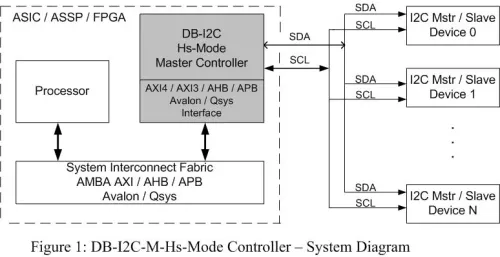The DB-I2C-M-Hs-Mode Controller IP Core interfaces a microprocessor via the AMBA AXI / AHB / APB Bus or Avalon Bus to an I2C Bus in Hs-Mode (3.4 Mbit/s) / Fast-Mode Plus (1 Mbit/s) / Fast-Mode (400 Kbit/s) / Standard-Mode (100 Kbit/s). The DB-I2C-M-Hs-Mode Controller IP Core can also interface a set of Registers within an ASIC / ASSP / FPGA device as well as interface Memory (e.g. SDRAM / SRAM / FLASH) to an I2C Bus.
The I2C is a two-wire bidirectional interface standard (SCL is Clock, SDA is Data) for transfer of bytes of information between two or more compliant I2C devices, typically with a microprocessor behind the master controller and one or more slave devices.
The DB-I2C-M-Hs-Mode is a Master I2C Controller that controls the Transmit or Receive of data to or from slave I2C devices. Figure 1 depicts the system view of the DB-I2C-M-AHB Controller IP Core embedded within an integrated circuit device.
In an ASIC / ASSP / FPGA integrated circuit, typically, the microprocessor is an ARM processor, but can be any embedded processor. Figure 1 depicts the system view of the DB-I2C-M-Hs-Mode Controller IP Core embedded within an integrated circuit device with its Microprocessor Configuration.
The DB-I2C-M-Hs-Mode Controller IP Core targets embedded processor applications with higher performance algorithm requirements. While most I2C controllers require high processor interaction involvement, the DB-I2C-M-Hs-Mode contains a parameterized FIFO and Finite State Machine Control for the processor to off-load the I2C transfer to the DB-I2C-M-Hs-Mode Controller. Thus, while the DB-I2C-M-Hs-Mode is busy, independently controlling the I2C Master-Transmit or Master-Receive transaction of data, the processor can complete other tasks. All Master Transmit / Receive transfers are with respect to the internal FIFO, thus fully isolating the processor from the I2C transfer of a block of data.
